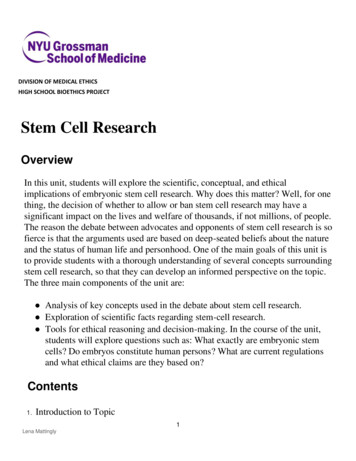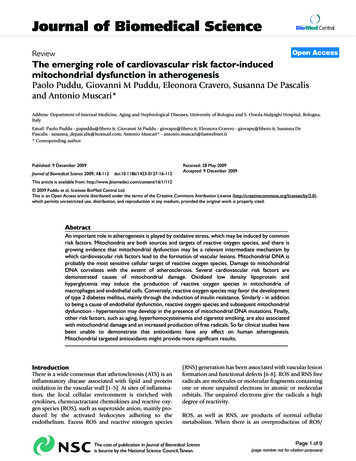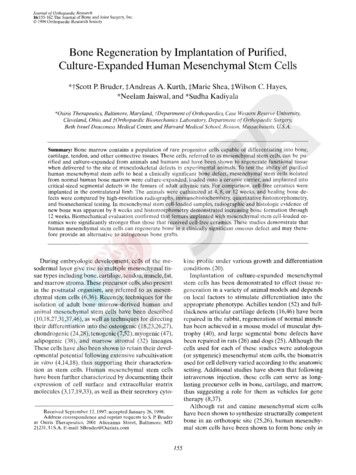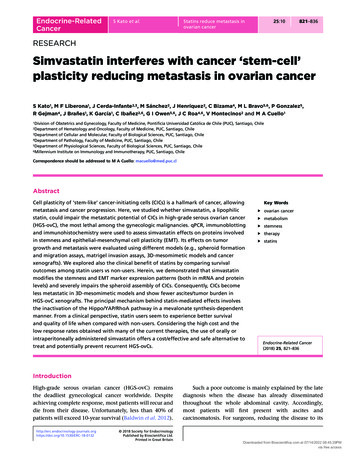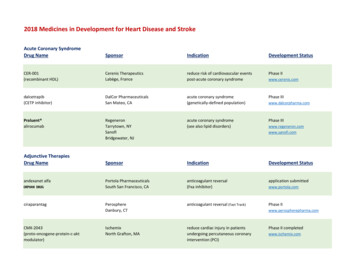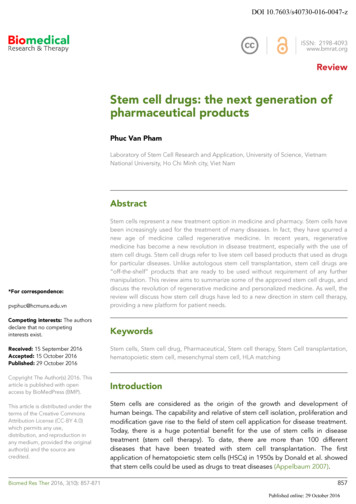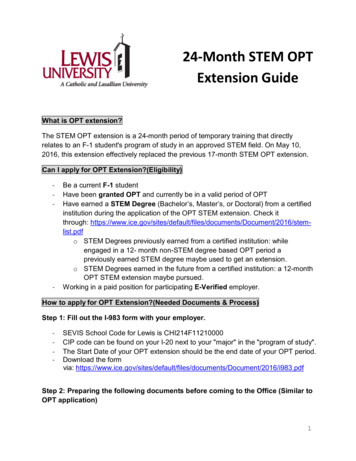
Transcription
Boukelmoune et al. Acta Neuropathologica 644-8(2018) 6:139RESEARCHOpen AccessMitochondrial transfer from mesenchymalstem cells to neural stem cells protectsagainst the neurotoxic effects of cisplatinNabila Boukelmoune, Gabriel S. Chiu, Annemieke Kavelaars and Cobi J. Heijnen*AbstractMesenchymal stem cells (MSCs) transfer healthy mitochondria to damaged acceptor cells via actin-basedintercellular structures. In this study, we tested the hypothesis that MSCs transfer mitochondria to neural stem cells(NSCs) to protect NSCs against the neurotoxic effects of cisplatin treatment. Our results show that MSCs donatemitochondria to NSCs damaged in vitro by cisplatin. Transfer of healthy MSC-derived mitochondria decreasescisplatin-induced NSC death. Moreover, mitochondrial transfer from MSCs to NSCs reverses the cisplatin-induceddecrease in mitochondrial membrane potential. Blocking the formation of actin-based intercellular structuresinhibited the transfer of mitochondria to NSCs and abrogated the positive effects of MSCs on NSC survival.Conversely, overexpression of the mitochondrial motor protein Rho-GTPase 1 (Miro1) in MSCs increasedmitochondrial transfer and further improved survival of cisplatin-treated NSCs.In vivo, MSC administration prevented the loss of DCX neural progenitor cells in the subventricular zone andhippocampal dentate gyrus which occurs as a result of cisplatin treatment. We propose mitochondrial transfer asone of the mechanisms via which MSCs exert their therapeutic regenerative effects after cisplatin treatment.Keywords: Mesenchymal stem cells, Neuronal stem cells, Mitochondrial transfer, CisplatinIntroductionMesenchymal stem cells (MSCs) have been shown to stimulate tissue repair in various disease models, including cardiomyopathy, pulmonary damage, cerebral ischemic insults, andneurodegenerative disorders like Alzheimer and Parkinsondisease [8]. Multiple mechanisms have been proposed to mediate these beneficial effects of MSCs, including suppressionof inflammation and release of growth factors. Recently, ithas become apparent that transfer of healthy mitochondriato damaged cells represents an important mechanism of endogenous regeneration. For example, astrocytes have beenshown to transfer mitochondria to neurons after ischemicstroke in mice [15]. MSCs also transfer mitochondria to cardiomyocytes in a model of anthracycline-induced cardiomyopathy [46], to murine alveoli in acute lung injury [17], tomurine lung epithelial cells in rotenone-induced airway injury [2], to cortical neurons in a model of cerebral stroke [5]* Correspondence: cjheijnen@mdanderson.orgLaboratory of Neuroimmunology, Department of Symptom Research, TheUniversity of Texas MD Anderson Cancer Center, 1515 Holcombe Blvd, Unit384, Houston, TX 77030, USAand to human monocyte-derived macrophages as well asmurine alveolar macrophages in models of acute respiratorydistress syndrome [18].Platinum-based chemotherapeutic agents, such as cisplatin, are widely used to treat solid tumors [19]. Increasingevidence indicates that cognitive deficits develop in cancerpatients treated with chemotherapy. Cognitive deficits induced by cancer treatment are characterized by confusion,memory loss, reduced attention and processing speed, anddecreased executive functioning [20–22, 39, 43]. Longitudinal neuropsychological studies report that up to 75% ofcancer patients experience cognitive problems during treatment and likely 35% of affected cancer patients havelong-term cognitive effects that seriously impair their quality of life [1].We recently reported that cisplatin induces cognitive impairment, synaptosomal mitochondrial dysfunction, andchanges in neuronal mitochondrial morphology in mice[7]. Nasal administration of MSCs to cisplatin-treated micerestored cognitive function and normalized mitochondrialfunction [6]. Lomeli et al. have demonstrated that The Author(s). 2018 Open Access This article is distributed under the terms of the Creative Commons Attribution 4.0International License (http://creativecommons.org/licenses/by/4.0/), which permits unrestricted use, distribution, andreproduction in any medium, provided you give appropriate credit to the original author(s) and the source, provide a link tothe Creative Commons license, and indicate if changes were made. The Creative Commons Public Domain Dedication o/1.0/) applies to the data made available in this article, unless otherwise stated.
Boukelmoune et al. Acta Neuropathologica Communications(2018) 6:139MSCs reduce cranial irradiation-induced brain damage as well [28].Neurogenic precursor proliferation and differentiation,particularly in the dentate gyrus (DG) of the hippocampus, is crucial to formation of new neurons, thereby enhancing neural circuity and improving learning andmemory [37, 41, 47]. Disruption of adult neurogenesiscontributes to the pathogenesis of many neurodegenerative diseases associated with cognitive impairment. Invivo and in vitro, cisplatin induces loss of neuronal precursors [3, 7, 28]. Gong el al. have shown that neuronalprecursors are very sensitive to low cisplatin concentrations [13].The aim of the present study was to test the hypothesis that MSCs can protect neuronal stem cells (NSCs)in culture, in vitro against the neurotoxic effects of cisplatin through mitochondrial donation. Moreover, we investigated whether nasal administration of MSCs in vivoprotects the brain neurogenic pools against the damaging effects of cisplatin.Materials and methodsAnimals9 weeks old C57BL/6 J male mice (Jackson Laboratory)were used. Mice were housed on a 12/12 h reversedark–light cycle. Animals had access to water and foodad libitum. All experiments were conducted at The University of Texas MD Anderson Cancer Center in Houston, Texas. Animals were used in accordance withInstitutional Animal Care and Use Committee-approvedprotocols.Page 2 of 13contains the pore-forming subunit of the mitochondrialcalcium uniporter to target the label to the mitochondria.The mito-mcherry plasmid was generated by cloning themito-GFP insert of the pLYS1-FLAG-MitoGFP-HA plasmid into the mcherry2-N1 vector (Addgene plasmid #54517, gift from Michael Davidson). The mitochondrialrho GTPase 1 (Miro1)-GFP overexpression plasmid(RhoT1, MG224107) was obtained from Origene(Rockville, MD, USA). Transfection of mito-GFP,mito-mcherry and Miro1-GFP plasmids were performed using either Lipofectamine LTX (Invitrogen)with Plus reagent for mito-GFP or mito-mcherry expression in MSCs or Lipofectamine 2000 (Invitrogen)and JetPrime (Polyplus Transfection, New York, NY,USA) for Miro1 overexpression, according to themanufacturer’s instructions.Chemotherapy and MSC treatmentCisplatin (2.3 mg/kg/day; Teva, Petah Tiva, Israel) orphosphate-buffered saline (PBS) was administered daily tomice intraperitoneally, following a 5 days injections and 5days rest scheme. Prior to MSC application, mice received3 μl of hyaluronidase in PBS in each nostril (100 U permouse, Sigma-Aldrich) to increase the permeability of thenasal mucosa [6, 10, 11, 16]. 30 min after, 3 μl of MSC cellsuspension (1 106 cells per mouse per day) or PBS wereadministered to mice, twice in each nostril, for a total of12 μl. MSCs were applied 48 and 96 h after the last cisplatin injection.Cell culture and transfectionCo-culture of MSCs and NSCsMouse cortical NSCs (R&D Systems, Minneapolis,MN, USA) were cultured in monolayers inlow-glucose Dulbecco’s Modified Eagle’s Medium(DMEM)/F12, supplemented with 100 U/mL penicillinand N-2 plus supplement (R&D Systems). Fibroblastgrowth factor basic and epidermal growth factor (both20 ng/mL; R&D Systems) were added to the culturesdaily. NSCs were cultured on surfaces coated withpoly-L-ornithine (Sigma-Aldrich, St. Louis, MO, USA)and bovine fibronectin (R&D Systems) and detachedusing Accutase (Innovative Cell Technologies, SanDiego, CA, USA).C57BL/6 mouse MSCs (Invitrogen) were grown in 5%CO2 at 37 C in DMEM/F12 medium with GlutaMax-I,supplemented with 10% MSC-qualified fetal bovine serumand 5 μg/mL gentamycin (all from GIBCO, Carlsbad, CA,USA). Before transfection, MSCs were seeded on platescoated with poly-L-lysine (Sigma-Aldrich). Cells were harvested using TrypLE-express (GIBCO). For labeling mitochondria we used pLYS1-FLAG-MitoGFP-HA (Addgeneplasmid # 50057; gift from Vamsi Mootha [35]) whichNSCs (35 104 cells) were plated on cell culture imagingdishes (ibidi, Fitchburg, WI, USA). Two days after plating,NSCs were treated with cisplatin (Teva, Petah Tikva,Israel) for 8 h, stained with 20 μM CellTracker Blue fluorescent probe (CTB; Invitrogen, Carlsbad, CA) for 45 minat 37 C, and washed in serum-free media. MSCs (15 104cells) were added to the culture for 17 h. Co-cultures werestained with wheat germ agglutinin (WGA) conjugates(WGA 488 or WGA 594, 1/300 dilution; Invitrogen) for10 min at 37 C, followed by 2 washes in Hank’s BalancedSalt Solution (GIBCO) prior to imaging in Live Cell Imaging Solution (Invitrogen).To inhibit actin polymerization, MSCs were treatedwith 2 μM Latrunculin B (Sigma-Aldrich) for 24 h priorto co-culture with NSCs. To assess NSC survival, CTBpositive NSCs were counted using the countess II FLautomated cell counter (Invitrogen). Mitochondrialtransfer was quantified in representative confocal images of every condition used, and the percentage of either mito-GFP-positive or mito-mcherry-positive NSCswas determined.
Boukelmoune et al. Acta Neuropathologica Communications(2018) 6:139Analysis of mitochondrial membrane potentialAfter exposure to cisplatin and co-culture with MSCs, cellswere stained with 250 nM of the fluorescent mitochondrialmembrane potential-sensitive dye tetramethylrhodaminemethyl ester (TMRM, Invitrogen) for 45 min at 37 C. As apositive control, NSCs were treated with 10 μM carbonilcyanide p-triflouromethoxyphenylhydrazone (FCCP), amitochondrial uncoupler, for 15 min. Cells were imaged byconfocal microscopy or washed with serum-free media andcollected in a single cell suspension for flow cytometry analysis. The fluorescence signal was detected with a BD accuriC6 Flow Cytometer (BD Biosciences, San Jose, CA USA) atFL2 emission of 585/40 nm. We used the TMRM insub-quench mode, as described previously [30, 33].Analysis of mitochondrial bioenergeticsTo assess mitochondrial bioenergetics, NSCs were grownin a Seahorse XFe 24 microplate (Seahorse Biosciences/Agilent Technologies, Santa Clara, CA, USA) coated withPoly-L-Ornithine and fibronectin to 80% confluency.NSCs were treated with 0.5–1 μM cisplatin or vehicle for12 h, washed with serum-free media, and incubated for 1h at 37 C in XF base media (Seahorse Biosciences) supplemented with 11 mM glucose, 2 mM glutamine, and 1mM pyruvate. Oligomycin (2 mM), FCCP (4 mM), androtenone/antimycin A (2 mM each) were used with a3-time repeat of a 2-min mix, 3-min wait, and 2-minmeasure assay cycle. Oxygen consumption rates were normalized to the total protein content of each well. Basalrespiration, adenosine triphosphate (ATP)-linked respiration, proton leak, and maximal respiratory capacity weredetermined as described previously [7, 23].ImmunohistochemistryImmunostaining of neural precursors in the dentate gyrus(DG) and subventricular zone (SVZ) was performed as previously reported [7]. Briefly, mice were euthanized and perfused with PBS followed by 4% paraformaldehyde (PFA).Brains were removed and fixed in 4% PFA for 48 h, paraffinembedded and sectioned at 8 and 10 μm for the SVZ andDG, respectively. Brain slices were stained for doublecortin(DCX, 1:50; Abcam, Cambridge, UK) followed by AlexaFluor 488 Donkey secondary antibody (Invitrogen) andDAPI. Sections were imaged and positive staining wasquantified using ImageJ. The number of DCX cells wasquantified in representative images by researchers blindedto treatment.To characterize NSCs, immunostaining was done aspreviously described [4]. Briefly, cells were fixed with 4%paraformaldehyde in PBS, treated with 0.25% TritonX-100, blocked in 2% BSA in PBS and stained with either anti-DCX antibody (1:50; Abcam, Cambridge, UK),anti Sox2 (1/200; Millipore, Burlington, MA), antiβIII-Tubulin (1/200; R&D Systems) or anti NestinPage 3 of 13(1/1000, Abcam) and anti-GFAP (1/200, Acris, Rockville,MD) in blocking buffer followed by secondary antibodyand DAPI. NSCs used for experiments were 52% Nestin , 17% GFAP , 16% Nestin/GFAP double-positive, 92%DCX , 94% Sox2 and 5% βIII-Tubulin .Confocal microscopyLive cell images of MSC and NSC co-cultures, fixedNSC staining as well as DCX expression in the DG andSVZ, were acquired using a SPE Leica Confocal Microscope (Leica Microsystems, Buffalo Grove, IL, USA) witha 63 X or 40 X objective, and analyzed with LAS X software. Image J was used to quantify TMRM intensity inindividual cells. Data are expressed as the corrected totalcell fluorescence integrated density – (area of selectedcell mean fluorescence of background readings) [31].Statistical analysisData are presented as mean standard error of the mean(SEM) of at least 3 independent experiments. Data were analyzed using GraphPad Prism 7 (GraphPad Software, LaJolla, CA, USA). One-way or two-way analysis of variance(ANOVA) was used with or without repeated measurefollowed by either Bonferroni’s or Tukey’s correction formultiple comparisons, Dunn’s multiple comparison or usingStudent’s t-test, as appropriate and indicated in the legends.ResultsMSCs rescue NSC from cisplatin-induced cell death invitro and in vivoNSCs were treated with 0, 0.5 or 1 μM cisplatin for 8 hand stained with Cell Tracker Blue fluorescent probe.Subsequently, the Cell Tracker Blue positive neuronswere co-cultured with MSCs for 17 h and recovery ofthe NSCs was quantified. Figure 1a shows that cisplatindose-dependently reduced NSC survival. Addition ofMSCs significantly increased survival of NSCs.Next, we tested whether MSCs also rescue NSCs fromcisplatin-induced cell loss in the DG of the hippocampusand the SVZ. Mice were injected with cisplatin during twocycles of 5 days (2.3 mg/kg) with 5 days of rest in between[7, 23]. One month after completion of cisplatin treatment, we observed a 40% decrease in the DCX neuralprogenitors in the DG of the hippocampus (Figs. 1f) and a50% decrease in the SVZ (Fig. 1k). Nasal application ofMSCs at 48 and 96 h after the last cisplatin dose reducedthe cisplatin-induced loss of DCX neuronal progenitorsin both the DG (Figs. 1f) and SVZ (Figs. 1k).Cisplatin induces mitochondrial damage in NSCsTo assess whether cisplatin induced mitochondrial damage in NSCs, we measured oxygen consumption rates ofNSC using the Seahorse XF24 extracellular flux analyzer(Fig. 2a). NSCs treated with cisplatin showed a marked
Boukelmoune et al. Acta Neuropathologica Communications(2018) 6:139APage 4 of 13BCDFEGHIJKFig. 1 MSCs rescue damaged NSCs after cisplatin treatment and reverse the loss of neuroblasts in the brain. a Neuronal stem cells (NSCs) were treatedwith cisplatin or vehicle for 8 h, stained with cell tracker blue (CTB), and subsequently co-cultured for 17 h with or without mesenchymal stem cells (MSCs).Survival of NSCs was assessed by counting the number of CTB-positive cells. The graph shows the rate of NSC survival after 17 h co-culture with MSCs(blue bars) or without MSCs (black bars). Data are normalized to survival in the absence of MSCs and cisplatin in each experiment and represent the mean SEM of 6 independent experiments. Data were analyzed using two-way ANOVA, repeated measures (cisplatin MSC interaction: P 0.01), followed byBonferroni’s post-hoc test. **** P 0.0001). (b-k) Animals were treated with cisplatin for 2 cycles of 5 days. DCX neuronal progenitors were observed inthe DG of the hippocampus (b-e) as well as the SVZ (g-j). The number of cells were counted in the DG tip (f). For the SVZ, the number of cells wasnormalized to the length of the SVZ (k). Data were analyzed by two-way ANOVA followed by Tukey’s post-hoc test. *P 0.05decrease in basal respiration as well as in oxygen consumption related to ATP production in comparison tocontrol conditions. Furthermore, cisplatin significantlyreduced maximal respiration as measured in the presence of FCCP (Fig. 2b).As a second measure of cisplatin-induced loss of mitochondrial integrity, we assessed mitochondrial membranepotential. NSCs were treated with cisplatin and labeled withthe mitochondrial membrane potential-sensitive dye tetramethylrhodamine methyl ester (TMRM). Using live-cell
Boukelmoune et al. Acta Neuropathologica Communications(2018) 6:139Page 5 of 13ABCDFig. 2 Cisplatin induces NSC mitochondrial dysfunction. Neuronal stem cells (NSCs) were treated with 1 μM cisplatin for 12 h. Oxygen consumptionrates (OCR) were analyzed using a Seahorse XFe 24 Analyzer and normalized to protein content (a). Mean basal, ATP production-related, andmaximum respiratory capacity (MRC) normalized to protein content were calculated (b). Results are expressed as means SEM of 3 independentexperiments. Data were analyzed using Student’s t-test: ** P 0.01; ***P 0.001; **** P 0.0001. NSCs were treated with 1 μM cisplatin for 8 h followedby 17 h in normal medium. Cells were stained with tetramethylrhodamine methyl ester (TMRM) and monitored immediately by live-cell imaging (c) orflow cytometry (d). NSCs treated with carbonilcyanide p-triflouromethoxyphenylhydrazone (FCCP, 10 μM for 15 min) were used as a positive control.Bar graphs represent mean SEM of 3 independent experiments. Data are normalized to mean fluorescence intensity of vehicle-treated cells in eachexperiment. Data were analyzed using One-way ANOVA followed by Bonferroni’s post-hoc test. *** P 0.001imaging, we observed that cisplatin decreased the TMRMsignal, indicating a reduction in mitochondrial membranepotential (Fig. 2c). Quantification of the change in TMRMstaining by flow cytometry showed that exposure of NSCsto cisplatin decreased mean TMRM fluorescence intensityby approximately 40%. This decrease in mitochondrialmembrane potential was similar to what we observed in response to the mitochondrial uncoupler FCCP, which wasused as a positive control (Fig. 2d).Mitochondrial transfer from MSC to cisplatin-treated NSCHaving shown that MSCs can protect NSCs againstcisplatin-induced cell death, we hypothesized that themechanism of the restorative effect of MSCs may involve donation of healthy mitochondria from MSCs tocisplatin-damaged NSCs. To test this possibility, we labeled the mitochondria in the MSCs using mito-GFP(Figs. 3) or mito-mcherry (Fig. 4) plasmids [35]. NSCswere treated with cisplatin or control medium for 8 h,followed by co-culture with MSCs containing the fluorescently tagged mitochondria. Confocal imaging revealed GFP or mcherry mitochondria in cisplatintreated NSCs, suggesting mitochondrial transfer fromMSCs to NSCs (Figs. 3 and 4). Quantitative assessmentof mitochondrial transfer showed that cisplatin dose-dependently increased the percentage of NSC that had received mitochondria from MSCs (Fig. 3c). Theorthogonal slice view in Fig. 4c demonstrates that theMSC-derived mitochondria are indeed localized insidethe cisplatin-treated NSC.
Boukelmoune et al. Acta Neuropathologica Communications(2018) 6:139Page 6 of 13ABCFig. 3 MSCs donate mitochondria to NSCs damaged by cisplatin. Representative confocal images of Neuronal stem cells (NSCs) treated with 1 μM cisplatin orvehicle for 8 h, stained with cell tracker blue (CTB) and subsequently co-cultured for 17 h with mesenchymal stem cells (MSC) transfected with mito-GFP (a andb) to label the MSC-derived mitochondria. Prior to confocal imaging, co-cultures were stained with wheat germ agglutinin (WGA) AF 594 (a and b) to revealcell membranes. GFP-positive mitochondria were detected in NSCs treated with cisplatin (b, right panel), indicating mitochondrial transfer. The extent ofmitochondrial transfer was quantified by counting the number of NSCs positive for the GFP signal in the co-cultures (c). Data are represented as the mean SEM of 3 independent experiments and were analyzed using One-way ANOVA followed by Bonferroni’s post hoc-test. **** P 0.0001MSC normalize mitochondrial membrane potential incisplatin-treated NSCsCisplatin treatment decreased TMRM staining in NSCs, indicating a reduction in mitochondrial membrane potential(Figs. 2 and 5). We next analyzed whether mitochondrialtransfer of MSCs to cisplatin-treated NSCs restored theirmitochondrial membrane potential. To that end, we compared TMRM staining in cisplatin-treated NSCs co-culturedwith or without mito-GFP-transfected MSCs (Fig. 5). TMRMstaining was markedly increased in those NSCs that receivedmitochondria from the MSCs (as shown by the presence ofmito-GFP-labeled mitochondria) in comparison with theNSCs that were negative for mito-GFP (Fig. 5). The latter results indicate that MSC-derived mitochondrial donation restores mitochondrial integrity of NSCs treated with cisplatin.Effect of Latrunculin B on transfer of mitochondria andNSC survivalMesenchymal stem cells (MSCs) can transfer mitochondria to other cells via formation of tunneling nanotubes(TNTs) and protrusions [18, 40]. To determine whethermitochondrial donation is crucial for NSC survival, wepre-incubated MSCs with latrunculin B (LatB, an inhibitor of f-actin polymerization) which has been shown toinhibit TNT formation [34].We assessed the effect ofLatB on mitochondrial transfer and NSC survival in theco-cultures with MSCs labeled with mito-mcherry. LatBreduced the transfer of mito-mcherry-labeled mitochondria to cisplatin-treated NSCs (Fig. 6d and e). Interestingly, LatB did not affect transfer of mitochondria tountreated NSCs (Figs. 6b and e). Moreover, LatB-treatedMSCs were no longer able to promote survival ofcisplatin-treated NSCs (Fig. 6f ) indicating that mitochondrial transfer by MSC contributes to NSC survival.Overexpression of Miro1 in MSC increases mitochondrialtransfer and promotes NSC survivalMiro-1 is an essential mediator of microtubule-based mitochondrial motility and contributes to mitochondrial transferbetween cells [2]. In our search to improve mitochondrial
Boukelmoune et al. Acta Neuropathologica Communications(2018) 6:139Page 7 of 13ABCFig. 4 Representative confocal images of Neuronal stem cells (NSCs) and mesenchymal stem cells (MSCs) co-cultures. NSCs were treated with either1 μM cisplatin or vehicle for 8 h, stained with cell tracker blue (CTB) and co-cultured with MSCs transfected with mito-mcherry plasmid (a and b) tolabel the mitochondria. Co-cultures were stained with wheat germ agglutinin (WGA) AF 488 (a and b) to reveal cell membranes before confocalimaging. mcherry-positive mitochondria were observed in NSCs treated with cisplatin (b, right panel) showing mitochondrial transfer. (c) Orthogonalslice view of NSC containing mcherry-positive mitochondria derived from MSCdonation by MSCs, we overexpressed Miro1 in MSCs usinga mitochondrial Rho GTPase 1 (Miro1)-GFP plasmid. NSCswere treated either with 1 μM cisplatin or vehicle for 8 h,and subsequently co-cultured with or without MSCs overexpressing Miro1 and mito-mcherry or MSCs transfectedwith control vector and mito-mcherry for 17 h. Overexpression of Miro1 in MSCs increased mitochondrial transfer to NSCs (Figs. 7b, d and e). Moreover, overexpressionof Miro1 in MSCs increased their positive effect on survival of cisplatin-treated NSCs (Fig. 7f).DiscussionHere we show for the first time that MSCs donate mitochondria to NSCs when damaged by cisplatin in vitro. Wealso show for the first time that the loss of DCX neuronalprecursors caused by administration of 2 cycles of cisplatincan be rescued by intranasal administration of MSCs.Transfer of mitochondria from MSCs to NSCs reversed thedecrease in mitochondrial membrane potential of thecisplatin-treated NSCs and favored their survival after cisplatin treatment. Blocking MSC-derived mitochondrialtransfer by inhibiting actin polymerization eliminated thebeneficial effect of MSCs on survival of cisplatin-treatedNSCs. Conversely, when mitochondrial transfer was enhanced by overexpression of the Rho-GTPase 1 (Miro1), amitochondrial motor protein, NSC survival after cisplatintreatment further increased. Collectively, our data supportthe model that MSCs can transfer mitochondria to damaged NSCs via formation of protrusions and tubular structures to rescue the latter ones after cisplatin treatment.MSCs have the potential to repair injuries by a variety ofmechanisms that range from secretion of paracrine factorsand transfer of proteins and RNA to the transfer of organelles such as mitochondria. It is now well recognized thatMSCs can transfer mitochondria to various cell types, including epithelial cells, macrophages, cardiomyocytes,neural cells and endothelial cells, in highly toxic orcell-damaging conditions [2, 5, 18, 26, 27, 44, 46]. As mentioned in the introduction, the transfer of mitochondriahas also been shown to occur in vivo and may assist inrescuing functional and bioenergetic properties of recipient cells in metabolic need [2, 5, 18, 26, 27, 44, 46].In our in vitro model of cisplatin-induced neurotoxicity, we observed that cisplatin treatment markedly increased the number of NSCs that received mitochondriafrom MSCs. This finding implies that cisplatin-treatedNSCs express a “danger signal” that prompts MSCs toinitiate mitochondrial transfer and therefore promotereparative functions. Several danger signals have beenhypothesized to function as inducers of mitochondrial
Boukelmoune et al. Acta Neuropathologica Communications(2018) 6:139Page 8 of 13ABCDEFig. 5 Mitochondrial transfer from MSCs to NSCs damaged by cisplatin restores mitochondrial membrane potential. Neuronal stem cells (NSCs)were treated with vehicle or 1 μM cisplatin for 8 h, stained with cell tracker blue (CTB), and subsequently co-cultured for 17 h with or withoutmesenchymal stem cells (MSCs) transfected with mito-GFP to label the mitochondria. Co-cultures were stained with tetramethylrhodaminemethyl ester (TMRM) and imaged. Confocal images of co-cultures show that NSCs exhibited a bright TMRM signal in control conditions (a and c)that was markedly reduced after cisplatin treatment (b). The mitochondrial membrane potential in cisplatin-treated NSCs was restored afterreceiving MSC-derived mitochondria labeled in green (d). MSCs do not uptake TMRM as well as NSCs (Additional file 1: Figure S1). TMRMfluorescence was quantified in individual NSCs (e). N 65 cells were quantified in each group. Data are represented as means SEM and wereanalyzed using One-way ANOVA followed by Dunn’s multiple comparisons test. *** P 0.001
Boukelmoune et al. Acta Neuropathologica Communications(2018) 6:139Page 9 of 13ABCDEFFig. 6 Effect of Latrunculin B on transfer of mitochondria and NSC survival. Representative confocal images of Neuronal stem cells (NSCs) stainedwith cell tracker blue (CTB) and subsequently co-cultured for 17 h with mesenchymal stem cells (MSC) transfected with mito-mcherry (a-d) tolabel the MSC-derived mitochondria. Neuronal stem cells (NSCs) were treated with 1 μM cisplatin or medium for 8 h followed by co-culture withmesenchymal stem cells (MSCs) treated with 2 μm Latrunculin B (MSC LatB, b and d), control MSC (MSC Ctl, a and c), or without MSC for 17 h.Mitochondrial transfer (e) and NSC survival (f) were quantified as in Figs. 1 and 3. Data are represented as means SEM of 4 independentexperiments and were analyzed using two-way ANOVA followed by Bonferroni’s post-hoc test. ** P 0.01; * P 0.05transfer. One possibility is that cells in need releasedamaged mitochondria and mtDNA that can then berecognized by MSCs via receptors for damage-associatedmolecular patterns, including toll-like receptors [12].The actual uptake of damaged mitochondria by MSCswas shown to be crucial for activating MSCs to rescuedamaged cardiomyocytes or human umbilical-vein endothelial cells, both in vitro and in vivo [29].Intercellular communication is crucial for the development and maintenance of tissue growth, differentiation,and regeneration. Cells are capable of establishing directcontact through various types of cell connections, such
Boukelmoune et al. Acta Neuropathologica Communications(2018) 6:139Page 10 of 13ABCDEFFig. 7 Overexpression of Miro1 in MSCs boosts NSC survival and enhances mitochondrial transfer to injured NSCs. Representative confocalimages of Neuronal stem cells (NSCs) stained with cell tracker blue (CTB) and subsequently co-cultured for 17 h with mesenchymal stem cells(MSC) transfected with mito-mcherry (a-d) and miro1-GFP (b, d) to label the MSC-derived mitochondria. Neuronal stem cells (NSCs) were treatedwith 1 μM cisplatin for 8 h and then co-cultured for 17 h with mesenchymal stem cells (MSCs) overexpressing Miro1 GTPase (MSC Miro1), MSCstransfected with empty vector (MSC Ctl), or without MSCs. Mitochondrial transfer (e) and survival (f) were assessed as in Fig. 6. Data wereanalyzed by two-way ANOVA followed by Bonferroni’s post-hoc test. ** P 0.01; * P 0.05as formation of cytoplasmic TNTs that enable the transfer of organelles such as mitochondria from one cell toanother. Studies have reported that one of the means bywhich MSCs make contact with injured cells andtransfer their mitochondria is via formation of these TNTs[2, 18, 26, 27]. Our finding that LatB reduces mitochondrial transfer indicates that MSCs use TNTs for deliveringtheir mitochondria. The molecular signal inducing theformation of TNTs is still unclear and seems to differbetween cell types [40]. Studies conducted in immunecells and HEK293T cells highlight the involvement of theM-Sec pathway, a 73-kDa cytosolic protein also known astumor necrosis factor α-induced protein 2 or B94, in inducing the membrane protrusion that is one of the first stepsin the formation of TNTs [14, 32]. In addition, the
nasal mucosa [6, 10, 11, 16]. 30min after, 3μl of MSC cell suspension (1 106 cells per mouse per day) or PBS were administered to mice, twice in each nostril, for a total of 12μl. MSCs were applied 48 and 96h after the last cis-platin injection. Co-culture of MSCs and NSCs NSCs (35 104 cells) were plated on cell culture imaging
